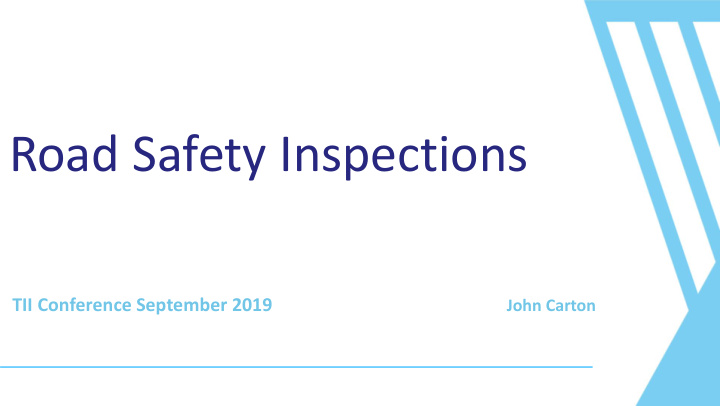



Road Safety Inspections TII Conference September 2019 John Carton
Road Safety Inspections Why do we do undertake RSI’s? The EU Directive on Road Infrastructure Safety Management (EU RISM • Directive 2008/96/EC) requires periodic safety inspections to be completed by the competent entity on the trans-European road network (TERN). The EU RISM Directive was transposed into Irish Law by the European • Communities (Road Infrastructure Safety Management) Regulations 2011 S.I 472 of 2011. Road Safety Inspections (RSI) are a new safety procedure that was • introduced by TII to comply with the above legislation.
Road Safety Inspections What are Road Safety Inspection’s (RSI)? The primary purpose of RSI’s are to identify issues along the road • network that relate to road safety. RSI is a proactive approach to improving the safety of the existing • national road network. The RSI requirements are described in AM-STY-06044 . • The process applies to all National Roads . • The RSI process is further described in AM-STY-06043. •
The Inspection Process RSI Teams are appointed from the TII framework for RSI’s and inspect on a route by route • basis.. The inspection teams drive and video the route, plus 200m up each side road, in each • direction during the hours of daylight and darkness and identify any potential safety issues. The issues are given an individual ID number, feasibility stage solutions and cost estimates • are developed and the issues are prioritised from 1 to 8, with 1 being the top priority. The information is then compiled into a draft feasibility report for submission to TII by the • RSI team. The draft reports are reviewed by the RSET and comments are given to the Inspection • teams. The feasibility reports are then finalised and formally issued to TII. • The RSI issues are then divided by county into TII “Internal” Items and ‘Local Authority • “External” Items.
Implementation of RSI External Issues. The RSI is divided into four regions nationally. • Each region has a dedicated Road Safety Inspection • Engineer. (RSIE) Each RSIE presents the RSI information to the relevant • LA’s (Local Authorities), who then review and commence developing and implementing interventions. Any questions on the RSI process can be directed to the • relevant RSIE.
Implementation of RSI External Issues. The RSIE presents the RSI information to the LA. • Data is available through the an ArcGIS Portal, spreadsheet format (Appendix A) and the RSI feasibility • Report document pdf. The LA reviews the RSI data and adds comments and cost estimates/forecast spend to the Appendix A • spreadsheet. The focus should be on Priority 1-5 issues initially. The RSIE reviews the LA comments and agrees an annual allocation amount. An single annual • cumulative allocation is preferred, however the funding allocation may be topped up depending on progress. The LA manage the implementation of the RSI solution including submission of feasibility reports, Road • safety Audit (RSA)*, Preliminary Design Report (PDR)* and procurement for each RSI issue. The documentation and level of detail required will depend on the issue being addressed. *if required Each LA is free to develop solutions in house or to utilise a consultant from the Road Safety Framework. • The RSIE reports quarterly to TII on progress and this is fed into by the LA. •
Presentation of RSI Data. ArcGIS Feasibility Report PDF Excel Spreadsheet (Appendix A)
RSI Delivery Process Flowchart
Opportunities and Challenges The RSI process is cyclical and the programme of re-inspection of the National routes will extend from 2020 to 2023. New • Feasibility Reports for some routes being available Jan 2021. The process and associated funding will therefore be on- going. The process works best if there is a single person to manage the RSI implementation within the Local Authority. • The Local Authority has the opportunity to add issues to their RSI list or to elevate Priority 6 – 8 issues. This must be • agreed with the RSIE. The scale of the RSI works (100’s of issues) can be daunting, however the process should be considered over the long • term. Establish realistic works programme and allocation request to reflect available resources. LA resourcing can and does present a challenge. Local Authorities should consider the dedication of resources to the RSI • process or the utilisation of specialist consultants from the Safety Framework. In house resources can be costed to the RSI process. These should be included in the cost estimates where necessary. • Consideration should be given to incorporating RSI issues into the scope of upcoming Pavement Schemes, Minor Projects, • Safety Schemes etc. The upcoming Road Safety Improvement Scheme Standard will clarify the requirements for the production • of reports for the advancement of RSI items
Examples Before RSI 35345, Priority 3; N25 Co. Waterford. Removal of a road side hazard (Rocks). After
Before RSI 45520, Priority 8. N52 Co. Offaly. Removal of a road side hazard, low level fence with a horizontal rail. Identified as a hazard by the RSI and the fence retro fit programme. After
RSI 19596, Priority 2; N81 Tullow, Co. Carlow. The RSI identified drainage issues where standing water could lead to a loss of control. The issue is being addressed as part of the Tullow PARR scheme, with agreement of KNRO, CCC & TII.
Existing Arrangement Design RSI 7548, Priority 5; N30 Good Counsel School, New Ross, Co. Wexford. Upgrade to the uncontrolled crossing, the scope expanded to include modifications to the bus bay, street lighting and installation of VAS signage.
END Thank You TII Conference September 2019 John Carton
Recommend
More recommend